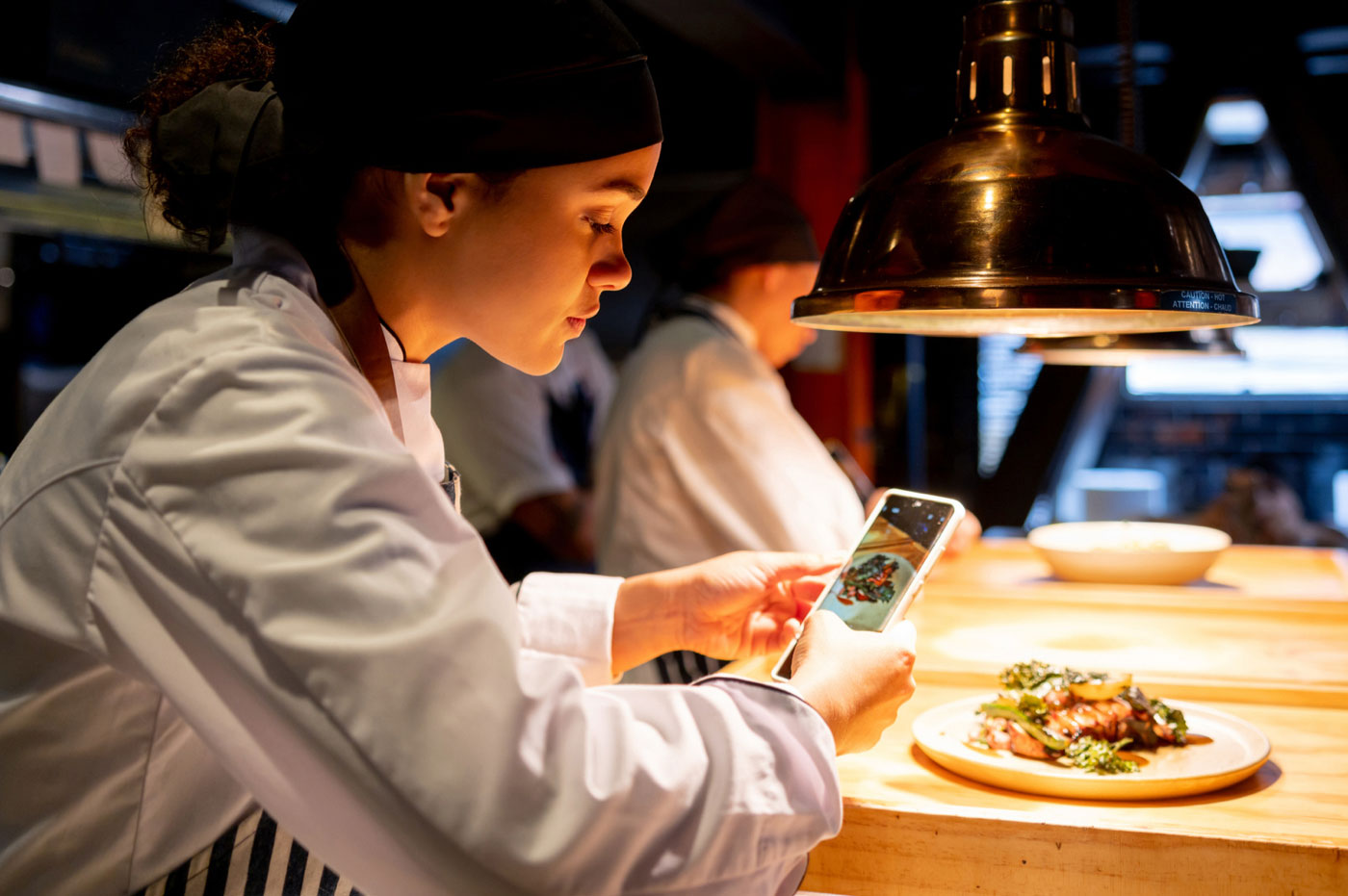Having a solid restaurant concept, delicious food, and a great location are just the beginning—but they only matter if people know about them. Consistent restaurant marketing helps ensure your business stays top of mind and brings customers through the door.
What is restaurant marketing?
Restaurant marketing refers to the strategies and tactics used to promote a restaurant’s brand, attract new guests, and build loyalty among current customers. Whether you’re a small neighborhood spot or part of a multi-location enterprise operation, investing in marketing can help you stay competitive, increase revenue, and fill empty tables.
Why should restaurants prioritize marketing?
Even the best food and service can’t drive business if people don’t know or forget that your restaurant exists. Marketing increases visibility and brand awareness, helping you stay top of mind with both new and returning customers. It also builds loyalty by creating ongoing touchpoints, like email campaigns and social media engagement, that keep guests coming back. Strategic marketing efforts can bring in customers during slow periods, promote special offers, and encourage larger orders. With most diners searching online before choosing where to eat, a strong digital presence—across your website, social media, and third-party listings—is essential. Marketing also gives you the chance to showcase what makes your restaurant unique, such as your menu, atmosphere, or role in the local community. Plus, marketing tools provide valuable data and insights, allowing you to track what’s working and make informed business decisions.
Let’s walk through the most effective marketing channels for restaurants and how to use each one successfully.
Email marketing
With an ROI of $36 to $40 for every dollar spent, email marketing remains one of the most powerful, cost-effective tools for restaurants. It allows you to reach guests directly in their inbox with personalized, timely messages that can drive action—whether that’s booking a reservation, placing a takeout order, or attending your next event.
CRM or email platform
To do email marketing well, you’ll need a reliable platform or CRM (customer relationship management) system that stores customer data, manages contacts, and sends campaigns. Look for a platform that supports segmentation, A/B testing, and provides robust analytics. It’s within this ecosystem that you can create an email campaign, which is a series of emails sent to a group of recipients with a specific purpose such as promoting an offer, making an announcement, or nurturing leads.
Email campaign tips
- Grow your list: Use signage, your website, and online reservations to collect emails. You can test incentivizing email signups with a small discount such as a free appetizer or dessert.
- Craft compelling copy: Keep subject lines short and engaging. When possible, personalize emails with customer names or local, timely references.
- Design for mobile: Over 40% of emails are opened on mobile devices. Implement single-column layouts, clear CTAs (call to actions), and responsive design.
- Time it right: Midweek late afternoons/early evenings tend to see higher open rates. It’s important to test and refine based on your audience.
- Track performance: Key metrics include open rates, click-through rates, and conversions. Use insights to improve future sends.
Social media marketing
Your guests are already spending over two hours each day on social media—so your brand should meet them there. Social media marketing lets you show off what makes your restaurant stand out, from mouthwatering dishes and signature drinks to your atmosphere, team, and candid moments. It’s also one of the most cost-conscious ways to build awareness, connect with your local community, and turn casual diners into loyal fans. From daily specials to hosting events, social media is where you tell your story and where your guests are most likely to share it.
Which platforms should you use?
- Instagram: Great for visuals—highlight your food, drinks, and ambiance.
- Facebook: Ideal for events, promotions, and community interaction.
- TikTok: Popular with younger audiences and great for viral content.
- X (formerly Twitter): Use for quick updates, brand voice, or joining industry trends.
Smart posting strategy
- Consistency is key: Aim for three to five posts per week.
- Best times to post: Share your posts Mondays through Thursdays between 10 a.m. and 1 p.m. for optimal results. You can also test posting during lunch (11 a.m. to 1 p.m.) or in the evening (5 p.m. to 7 p.m.) when your followers are deciding what to eat.
- Tailor content by platform: Try using high-quality photos on Instagram, community shoutouts on Facebook, time-sensitive updates on X, and behind-the-scenes videos on TikTok.
- Engage often: Respond to comments, answer questions, and reshare customer posts to help boost loyalty and conversion.
- Influencer marketing: Consider partnering with local foodies or micro-influencers to reach new audiences. Offering them complimentary meals or event invites can generate authentic interest and engagement without breaking your budget.
Mobile marketing
Mobile marketing ensures your restaurant is easily accessible and appealing to guests on the go. Today’s diners are searching, booking, and ordering from their phones—so a mobile-first approach is no longer optional, it’s a must. A responsive, fast-loading website is critical. It should feature your menu, location, hours, photos, online ordering/reservation links, and clear CTAs. A mobile-optimized website is designed to load quickly, adjust seamlessly to smaller screens, and provide a smooth user experience without the need for pinching or zooming. It should make it effortless for guests to find the information they need within seconds.
Mobile app
A well-designed app allows guests to engage directly with your brand, place orders, earn rewards, and receive exclusive updates—all from one central place on their phone. In fact, 51% of customers say they find deals via a restaurant’s app. If you have multiple locations or a loyal base, an app can streamline ordering and encourage repeat visits through gamification and push notifications. Your app can also collect valuable insights on user behavior, helping you optimize promotions, understand preferences, and improve your overall marketing strategy.
Third-party listings
In today’s digital-dominant world, 90% of diners are researching restaurants online before choosing where to eat and are often discovering restaurants through third-party listings before they ever land on your website. That means your online presence needs to extend far beyond your own domain. Listings on Google Business, Yelp, TripAdvisor, and other directories are frequently the top results in search engines and play a major role in influencing dining decisions. Keeping your information accurate, consistent, and up to date across all these platforms can build trust, boost your visibility in local searches, and help convert online interest into foot traffic.
- Map listings: When someone searches “best tacos near me,” does your restaurant show up? Ensure your business appears in local searches by keeping your Google Business Profile, Apple Maps, and other map-based platforms accurate and up to date. Include current hours, location, photos, and links to your website or menu. This is often the first touchpoint for mobile users making quick dining decisions.
- Review sites and restaurant directories: Sites like Yelp, TripAdvisor, and OpenTable carry major influence. Claim your profiles so you can respond to reviews, update business info, and add high-quality photos. Restaurants that actively manage their presence on these platforms tend to rank higher and earn more trust from diners.
- Delivery and ordering apps: If you’re listed on platforms like DoorDash, Uber Eats, Grubhub, or ChowNow, treat those listings like an extension of your brand. Keep your menu updated, ensure your photos reflect your food accurately, and regularly review your ratings. A clean, well-maintained profile can improve order volume and repeat customers.
- Social media platforms: While not traditional listing sites, social media platforms like Instagram, Facebook, and TikTok are often where diners first discover new restaurants—especially via tags, shares, or influencer posts. Make sure your business profiles are complete, consistent, and easy to find through search or location tagging.
Final thoughts
Restaurant marketing doesn’t have to be complicated, but it does need to be consistent. No matter if you’re building an email list, refining your social media presence, optimizing for mobile, or managing third-party listings, every effort can help increase visibility, build loyalty, and drive revenue. The key is consistency, creativity, and using the right channels to connect with your ideal customers. As the restaurant industry landscape continues to evolve, so should your marketing strategy. In short, marketing isn’t just an add-on—it’s a key ingredient in running a successful, sustainable restaurant business.
Want to learn more about how Rewards Network can help your restaurant grow?
Contact us today:
[email protected]
(800) 617-6067
RewardsNetwork.com
The information contained in this digital content is provided for informational purposes only and should not be construed as providing tax, legal, accounting, career, business, or other professional advice. You should consult your own professional advisors before engaging in any course of action. Individual results on the Rewards Network platform will vary.
© 2025 Rewards Network Establishment Services Inc. All Rights Reserved.






